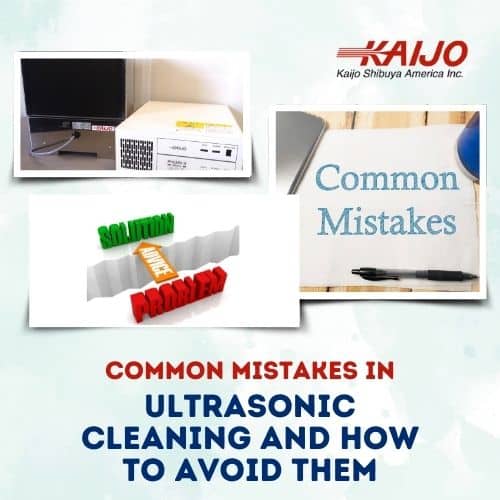Common Mistakes in Ultrasonic Cleaning and How to Avoid Them
February 11, 2025
 Chemical-based cleaning methods present significant challenges for manufacturers, including high disposal costs, workplace hazards, and increasing complexity due to regulatory compliance. Industrial ultrasonic cleaners revolutionize cleaning processes by utilizing cavitation energy instead of harsh chemicals, making them a safe, sustainable, and highly effective solution.
Chemical-based cleaning methods present significant challenges for manufacturers, including high disposal costs, workplace hazards, and increasing complexity due to regulatory compliance. Industrial ultrasonic cleaners revolutionize cleaning processes by utilizing cavitation energy instead of harsh chemicals, making them a safe, sustainable, and highly effective solution.
Ultrasonic cleaning technology relies on microscopic bubbles created by ultrasonic waves, collapsing against surfaces to eliminate stubborn contaminants effectively. The method offers many advantages:
Benefits of Ultrasonic Cleaning Solutions:
- Lowers disposal costs by eliminating chemicals– Reducing the financial burden of chemical waste management.
- Minimizes workplace hazards – Replacing toxic solvents with a safer, physical cleaning alternative.
- Simplifies compliance – Meeting industrial regulations without harmful chemicals is easier.
- Provides consistent results – High precision ensures uniform cleaning performance.
- Supports sustainable practices – Environmentally friendly with no chemical runoff.
This article discusses the most common mistakes and explains how to achieve optimal results using ultrasonic cleaning systems.
How Industrial Ultrasonic Cleaners Achieve Precise Results
Ultrasonic cleaning relies on the power of cavitation—a physical process where ultrasonic waves produce microscopic bubbles in the cleaning solution. When these bubbles collapse against a surface, they release energy that dislodges contaminants like dirt, oil, and microscopic particles from even the most complex surfaces. Unlike chemical-based methods, this process achieves highly precise cleaning without causing damage to sensitive components.
Key System Parameters for Optimal Cleaning Efficiency
1. Frequency Selection
Selecting the correct ultrasonic cleaning frequency is crucial to achieving optimal results, as it directly influences how the ultrasonic waves interact with different materials and contaminants.
- 26–38 kHz: Best for hard materials like steel and brass that require heavy-duty cleaning of contaminants such as grease or thick carbon deposits.
- 78–200 kHz: Ideal for softer metals and applications where medium-fine particulate removal is required.
- 430 kHz–2 MHz: Perfect for delicate components, including semiconductor parts and sensitive electronic surfaces.
Tip: Higher frequencies provide more precise cleaning but less aggressive action, while lower frequencies are better for removing stubborn contaminants.
2. Power Distribution
Consistent power output is essential for uniform cleaning. Insufficient or poorly distributed power creates “cold spots,” where cleaning effectiveness is significantly reduced.
- Kaijo’s Water Resonance System (WRS) enhances power distribution by conditioning the water, improving cavitation energy by up to 500%.
- Using the correct ultrasonic generator ensures consistent power output for uniform cleaning results, eliminating performance gaps across the tank.
3. Waveform Technology
Advanced waveforms improve cleaning efficiency by ensuring even energy coverage and effective cavitation in hard-to-reach areas.
- Hyperwave Form Technology: Enhances cleaning precision, making it ideal for irregular or complex components.
- FM Modulated Waves: Improves cleaning uniformity by varying the frequency of the ultrasonic waves within a defined range. This variation minimizes the creation of “standing waves” or areas in the cleaning tank where cavitation bubbles form unevenly, leading to inconsistent cleaning results.
Practical Insight: Selecting the right combination of frequency, power, and waveform technology is essential for maintaining cleaning consistency and avoiding damage, regardless of the complexity of the application.
By prioritizing these system parameters and understanding their interactions, you can optimize ultrasonic cleaning systems for precise, consistent, and effective results. This eliminates performance inefficiencies and helps avoid costly system downtime.
Common Mistakes When Using Industrial Ultrasonic Cleaners
To maximize the performance of industrial ultrasonic cleaners, it’s critical to avoid these five common mistakes:
Mistake 1: Using the Wrong Frequency
Problem: Selecting the wrong frequency can result in insufficient cleaning or component damage. Low frequencies on delicate parts generate too much power, while high frequencies can fail to clean heavily contaminated, hard surfaces effectively.
Solution:
- Low (26-38 kHz): For hard materials with heavy contamination.
- Mid (78-200 kHz): For moderate cleaning on softer metals.
- High (430 kHz-2 MHz): For extremely delicate or fragile components.
Mistake 2: Inappropriate Cleaning Solution
Problem: Using a generic or incompatible cleaning solution can cause component degradation or fail to remove specific contaminants. This wastes energy, increases costs, and impacts product quality.
Solution:
- Match cleaning solution formulations to the contaminant type and material compatibility.
- Ensure proper solution maintenance (e.g., avoid exceeding concentration thresholds).
- Test and validate solutions before integrating them into standard protocols.
Mistake 3: Incorrect Loading of Components
Problem: Improper placement of parts can obstruct ultrasonic waves. Overlapping components create “shadow zones,” where certain areas receive little to no cleaning.
Solution:
- Use racks and fixtures to arrange components with even spacing.
- Prevent direct part contact to ensure full exposure to ultrasonic waves.
- Implement operator training to standardize loading techniques.
Mistake 4: Insufficient Power Output
Problem: Undersized power systems produce weak cavitation energy, leading to incomplete cleaning. Operators often extend cleaning cycles to compensate, increasing operational costs without achieving better results. Pairing the system with a correctly sized ultrasonic generator optimizes power output, ensuring consistent cavitation energy throughout the tank.
Solution:
- Match power density to the tank size and load requirements.
- Use Kaijo’s WRS system to enhance power and ensure evenly distributed energy.
- Consider multi-transducer setups for larger tanks.
Mistake 5: Improper Water Conditioning
Problem: Using unconditioned water degrades acoustic properties, reducing cavitation intensity by up to 80%. This leads to inconsistencies and higher energy usage.
Solution:
- Optimize cavitation energy with Kaijo’s WRS system for up to 500% efficiency gains.
- Use Kaijo’s Phenix Hyper System to create a Hyperwave form or FM-modulated wave to produce a 3-dimensional cleaning effect.
Practical Solutions to Optimize Ultrasonic Cleaning
Implement these targeted tips to enhance cleaning results:
1. System Parameter Optimization
- Use the appropriate frequency for each cleaning application.
- Monitor power output to avoid weak areas in the tank.
- Implement Kaijo’s Hyperwave form or WRS system for enhanced cleaning.
2. Component Preparation and Loading
- Use racks designed to ensure uniform wave exposure.
- Create visual guides for proper spacing and placement.
- Inspect loading practices during cleaning cycles to identify potential issues.
3. Process Control Measures
- Regularly monitor water quality and solution composition.
- Log successful cleaning configurations for future consistency.
- Establish preventive maintenance schedules for the system.
4. Quality Assurance Steps
- Perform random inspections to verify cleaning completeness.
- Validate cleaning results under a microscope or through testing protocols.
- Record and analyze data trends to detect early signs of system degradation.
Troubleshooting Common Ultrasonic Cleaning Problems
1. Poor Cleaning Performance
Symptoms:
- Persistent contaminants or uneven cleaning results.
- Increased cleaning time needed.
Checklist:
- Verify frequency settings align with material and contamination levels.
- Inspect for cold spots caused by insufficient ultrasonic energy.
- Ensure correct spacing and orientation of loaded components.
2. Power Issues
Symptoms:
- Weak cavitation across tank zones.
Solutions:
- Check generator output for consistency.
- Upgrade to Kaijo’s WRS system for uniform cavitation.
3. Water Conditioning Problems
Symptoms:
- Reduced cleaning intensity or uneven results.
Solutions:
- Optimize cavitation energy with Kaijo’s WRS system.
- Leverage Kaijo’s Hyperwave or FM-modulated waves to counteract uneven energy dispersion.
Reach out to Kaijo’s experts for assistance with persistent ultrasonic cleaning challenges.
Conclusion
Avoiding common mistakes using industrial ultrasonic cleaners — such as improper frequencies, poor water conditioning, or inadequate power — ensures superior results while minimizing costs. Kaijo’s technologies, including the WRS system and Hyperwave form technology, significantly enhance cleaning efficiency and results.
Contact Kaijo today to solve your cleaning challenges with guidance from ultrasonic experts, who can help design a system for your exact specifications.





